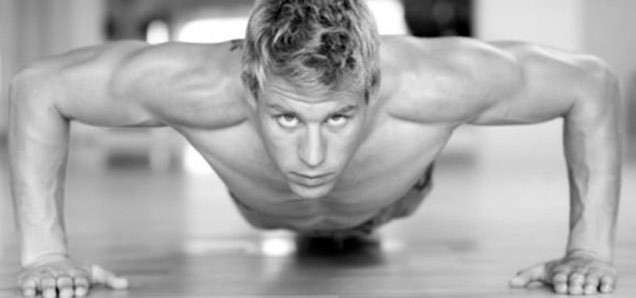No money? No problem!
 CREDIT: FITNESS-101.CO.UK
CREDIT: FITNESS-101.CO.UKYou don�t need a gym to do a push up.
Many people think that in order to be ‘fit,' they also have to possess wealth. They usually provide two reasons for their assertion: first, according to their knowledge, one must be a member of a gym to obtain the very least amount of results. They also suggest no one can exercise without equipment. Second, they contend that because a personal trainer is knowledgeable of fitness, one cannot gain improvements if they do not have a personal trainer. Although these points are somewhat valid, the majority of the population is very misguided: fitness does not require the expenses of either a membership, equipment or that of a personal trainer, according to Weight Training, an illustrated guide book by maranGraphics. For each of these reasons, then, one must not focus on the cost of fitness; instead, one should focus on how to achieve improvements in their fitness.
When the general population states that one must acquire a membership at a fitness centre, they neglect one key point: exercise does not have to be contained within the boundaries of a fitness facility, according to Weight Training. There are many reasons to support this statement. First, exercise is defined by Dictionary.com as “bodily or mental exertion, especially for the sake of training or improvement of health.” Within this definition, there are no limitations on the environmental area for one to perform exercise. Second, there are many examples of exercises that do not need to be executed in a gym, such as jogging, dancing, swimming and hiking. It is important to identify that none of those exercises need to be done in a gym, nor do they require equipment. Lastly, research shows that for an exercise program to be considered complete, it must consist of aerobic fitness, muscular fitness and flexibility, states the American College of Sports Medicine's book Complete Guide to Fitness & Health. To add, all of these attributes can be achieved outside or at home. For instance, jogging (aerobic fitness) can be done outside, push-ups (muscular fitness) can be executed at home, and stretching (flexibility) can be performed at home as well. In short, a complete fitness program does not need to be executed at a public gym; rather, it can be executed in the comfort of one's home, and surrounding environment.
Although a personal trainer is ideal when developing and executing an effective workout program, one's results are not dependent on the effectiveness of a personal trainer. Recent studies prove that there are various low-cost approaches to constant increases in the health care system, such as personal training. These strategies require an individual to be self-motivated, and being in the preparation stage of change. This state of change is the point at which a person is preparing to make a change in their habits, according to the book Health Promotion Throughout the Life Span. Similarly, to accomplish goals, one must follow the two main principles of training: overload and specificity. Complete Guide to Fitness & Health describes ‘overload' as doing enough work to provide lasting change, and ‘specificity' as executing the correct type of work. These two attributes are commonly known as the acronym F.I.T.T. (Frequency, Intensity, Time/Amount, and Type). To add, it is beneficial to use perceived exertion to monitor intensity while exercising. Perceived exertion can be described as one's view of the level of intensity they are working at: very low, low, low-to-moderate, moderate, moderate-to-high, high, and very high. If one follows the guidelines given in F.I.T.T., along with perceived exertion, one will be successful in accomplishing their goals in any of the health-related components of fitness: cardiovascular endurance, flexibility, muscular endurance, muscular strength, and body composition. Furthermore, in regards to training the body, because one can perform countless exercises that can be categorized into the principles of overload and specificity, one can execute an effective training program by themself in the comfort of their home or surrounding environment. Therefore, one does not need to waste money on a personal trainer because they can do a complete workout on their own by following the protocol of overload and specificity.
Exercise is a very broad term. This can cause confusion, and many people who want to get healthy spend money blindly in several areas to achieve results. Throughout this article, I've made three things clear. First, exercise does not have to cost anything to perform, and the common expenses of a gym membership, equipment and a personal trainer are helpful, but are definitely not mandatory. Second, a complete training program can be executed in the comfort of one's home and surrounding environment. Finally, one can use perceived exertion to properly use the two principles of training: overload and specificity.
In short, one does not have to be wealthier to become physically healthier.
Brian Reynolds is a Fitness and Health Promotion student at Fanshawe College.
Editorial opinions or comments expressed in this online edition of Interrobang newspaper reflect the views of the writer and are not those of the Interrobang or the Fanshawe Student Union. The Interrobang is published weekly by the Fanshawe Student Union at 1001 Fanshawe College Blvd., P.O. Box 7005, London, Ontario, N5Y 5R6 and distributed through the Fanshawe College community. Letters to the editor are welcome. All letters are subject to editing and should be emailed. All letters must be accompanied by contact information. Letters can also be submitted online by clicking here.













